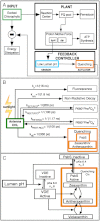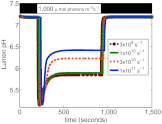A kinetic model of rapidly reversible nonphotochemical quenching
- PMID: 22891305
- PMCID: PMC3465407
- DOI: 10.1073/pnas.1211017109
A kinetic model of rapidly reversible nonphotochemical quenching
Abstract
Oxygen-evolving photosynthetic organisms possess nonphotochemical quenching (NPQ) pathways that protect against photo-induced damage. The majority of NPQ in plants is regulated on a rapid timescale by changes in the pH of the thylakoid lumen. In order to quantify the rapidly reversible component of NPQ, called qE, we developed a mathematical model of pH-dependent quenching of chlorophyll excitations in Photosystem II. Our expression for qE depends on the protonation of PsbS and the deepoxidation of violaxanthin by violaxanthin deepoxidase. The model is able to simulate the kinetics of qE at low and high light intensities. The simulations suggest that the pH of the lumen, which activates qE, is not itself affected by qE. Our model provides a framework for testing hypothesized qE mechanisms and for assessing the role of qE in improving plant fitness in variable light intensity.
Conflict of interest statement
The authors declare no conflict of interest.
Figures



 . (C) Difference in NPQ between wild type and npq4, which is a measure of qE. The black bar at the top of each figure indicates times when the plant is darkened, and the white bar indicates actinic light illumination.
. (C) Difference in NPQ between wild type and npq4, which is a measure of qE. The black bar at the top of each figure indicates times when the plant is darkened, and the white bar indicates actinic light illumination.


Comment in
-
Modeling the protection of photosynthesis.Proc Natl Acad Sci U S A. 2012 Sep 25;109(39):15533-4. doi: 10.1073/pnas.1213195109. Epub 2012 Sep 18. Proc Natl Acad Sci U S A. 2012. PMID: 22991475 Free PMC article. No abstract available.
Similar articles
-
Characterization of a nonphotochemical quenching-deficient Arabidopsis mutant possessing an intact PsbS protein, xanthophyll cycle and lumen acidification.Planta. 2006 Feb;223(3):532-41. doi: 10.1007/s00425-005-0093-z. Epub 2005 Sep 1. Planta. 2006. PMID: 16136330
-
An underlying mechanism of qE deficiency in marine angiosperm Zostera marina.Photosynth Res. 2021 Jun;148(3):87-99. doi: 10.1007/s11120-021-00836-0. Epub 2021 May 2. Photosynth Res. 2021. PMID: 33934290
-
Regulation of photoprotection gene expression in Chlamydomonas by a putative E3 ubiquitin ligase complex and a homolog of CONSTANS.Proc Natl Acad Sci U S A. 2019 Aug 27;116(35):17556-17562. doi: 10.1073/pnas.1821689116. Epub 2019 Aug 12. Proc Natl Acad Sci U S A. 2019. PMID: 31405963 Free PMC article.
-
The evolution of the photoprotective antenna proteins in oxygenic photosynthetic eukaryotes.Biochem Soc Trans. 2018 Oct 19;46(5):1263-1277. doi: 10.1042/BST20170304. Epub 2018 Aug 28. Biochem Soc Trans. 2018. PMID: 30154089 Review.
-
Toward an understanding of the mechanism of nonphotochemical quenching in green plants.Biochemistry. 2004 Jul 6;43(26):8281-9. doi: 10.1021/bi0494020. Biochemistry. 2004. PMID: 15222740 Review.
Cited by
-
Optimization of ATP Synthase c-Rings for Oxygenic Photosynthesis.Front Plant Sci. 2020 Jan 30;10:1778. doi: 10.3389/fpls.2019.01778. eCollection 2019. Front Plant Sci. 2020. PMID: 32082344 Free PMC article.
-
Leaf Energy Balance Requires Mitochondrial Respiration and Export of Chloroplast NADPH in the Light.Plant Physiol. 2019 Aug;180(4):1947-1961. doi: 10.1104/pp.19.00624. Epub 2019 Jun 18. Plant Physiol. 2019. PMID: 31213510 Free PMC article.
-
Unique photosynthetic strategies employed by closely related Breviolum minutum strains under rapid short-term cumulative heat stress.J Exp Bot. 2024 Jul 10;75(13):4005-4023. doi: 10.1093/jxb/erae170. J Exp Bot. 2024. PMID: 38636949 Free PMC article.
-
A generalised dynamic model of leaf-level C3 photosynthesis combining light and dark reactions with stomatal behaviour.Photosynth Res. 2019 Jul;141(1):99-118. doi: 10.1007/s11120-018-0601-1. Epub 2018 Nov 23. Photosynth Res. 2019. PMID: 30471008
-
The slow phase of chlorophyll a fluorescence induction in silico: Origin of the S-M fluorescence rise.Photosynth Res. 2016 Dec;130(1-3):193-213. doi: 10.1007/s11120-016-0243-0. Epub 2016 Mar 19. Photosynth Res. 2016. PMID: 26995191
References
-
- Melis A. Photosystem-II damage and repair cycle in chloroplasts: What modulates the rate of photodamage in vivo? Trends Plant Sci. 1999;4:130–135. - PubMed
-
- Kulheim C, Agren J, Jansson S. Rapid regulation of light harvesting and plant fitness in the field. Science. 2002;297:91–93. - PubMed
-
- de Bianchi S, Ballottari M, DallOsto L, Bassi R. Regulation of plant light harvesting by thermal dissipation of excess energy. Biochem Soc Trans. 2010;38:651–660. - PubMed
Publication types
MeSH terms
Grants and funding
LinkOut - more resources
Full Text Sources

